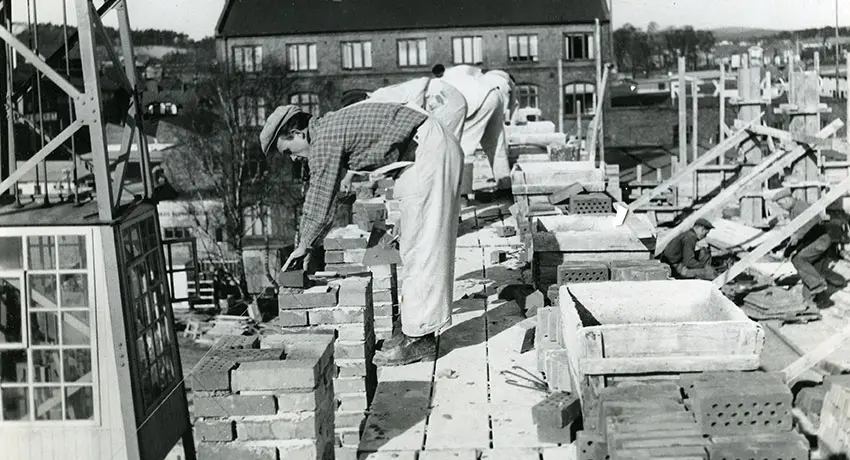- Startsida
- Halmstads Teater
- En
- About the theater
- History
History
The 13th of November 2019 was a special day. On that day we celebrated out 65th birthday. In this building, we and our visitors have shared a wealth of amazing, fun and dramatic experiences over the years. Halmstad Theater is a stage of the future, but its story starts with a history lesson.
Halmstad Theater first opened its doors in 1954. Plans for a theater building had long been in place, but had not yet been realised. Since 1866, the city’s theater had been housed in Hotell Mårtensson on Storgatan, where travelling theater companies performed.
In 1918, the City Council proposed an investigation to solve the growing city’s need for a larger theater and concert hall. The politician Fritz Gyllensvärd, a theater enthusiast and baker, was very committed to making this a reality. When he died in 1927, he left a donation of SEK 100,000 to Halmstad “to facilitate the construction of a theater and to some extent secure its operation”.
Architects competed for the job
In the 1930s, an architectural competition was held for the design of a theater building. Fifty proposals were submitted, and the winner (by 35 votes to 1) was the Gothenburg-based architect Sven Brolid. But before long World War II broke out, forcing construction to be postponed. When the war was over, the planning resumed. The state contributed SEK 242,000 from the Lottery Fund. A breakthrough for the construction of the theater occurred when politicians proposed an investigation into whether the theater building could be combined with a new Folkets Hus.
KFAI’s Gösta Hedström was hired as an architect, and he worked on the project for nine years. By the time the theater opened in the autumn of 1954, it is estimated that approximately 300,000 working hours had been spent on the project. The total labour costs amounted to SEK 5.5 million.

Ornamentation
Halmstad Theater is richly adorned with art. The artists who contributed their works helped make the theater a building of national interest. Today, many of them are famous. The theater’s foyer features a large mural to which all the artists in the Halmstad Group contributed. It was created between 1953 and 1954. Because Halmstad Theater is so richly adorned with art, we have assembled more information about our artworks and the artists behind them on a separate page. Read more about the art at Halmstad Theater.
The theater building’s exterior
The colossal concrete and brick facade of Halmstad Theater faces Österbro Bridge and the city centre. 3,800 cubic metres of concrete and 20,000 sacks of cement were used for its construction. In addition, 250,000 bricks have been Folkets Hus section of the building.
During the inauguration, a journalist from Hallandsposten wrote “It has an exterior that impresses thanks to its clean surfaces. The Functionalist style in which the architects worked has created a sense of festivitas without ostentation, and monumentality without overbearingness. Anyone who takes the time to look more closely will discover how small, seemingly insignificant details complete the whole.”
Even at the time, the theater’s unique style was recognised and the building quickly became famous all over the country, not least because it housed the largest theater in the country.
*) festive atmosphere, festive joy, festive radiance, splendour, pomp, circumstance, solemnity

The theater building’s interior
Teatersalongen is accessed through a spacious entrance via an upper floor that is also equipped with a wardrobe and refreshments stand. There was room for 756 people in the parquet circle, and the balcony could accommodate another 191. There were thus a total of 947 spectator seats – all according to the original drawings.
The theater building also housed a restaurant that often served as a venue for jazz concerts. Once a cinema, Figarosalen is a “building within the building”. This was partly for security reasons, but the design also meant that the cinema could conduct its business without interfering with performances in Stora Salongen (the main auditorium).
The premiere
At the November 1954 premiere, August Strindberg’s “The Dance of Death” was directed by Karin Kavli and featured several well-known actors: Karin Kavli herself, Kolbjörn Knudsen, Erland Josephsson, Mona Dan-Bergman and Alica Florin. The performance was given ample coverage in the local press – where it was touted as one of Strindberg’s greatest works.
Film from the Swedish Film Institute and SVT International.
Click on the gear at the bottom right of the movie box to turn on English subtitles.
The present day
- In 2010, the stage area underwent a major renovation. During that time, the theater stood empty for 15 months.
- In the summer of 2012, Stora Salongen’s audience seats were replaced.
- In the spring of 2020, Halmstad Tourist Center moved into the lower foyer. The rest of the Destination Halmstad company also moved into the property.Among other things, the entrance of the Figaro Hall will be renovated in 2022.
- An exciting future awaits our theater building, which is a listed cultural site.
- During 2020 and 2021, the boxes and green rooms were refurbished.
- In 2022, the Figarosalen's entrance was renovated.
